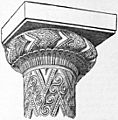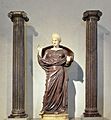Pillar facts for kids
A pillar is a strong, upright support. It's often used in buildings to hold up roofs or other parts. Think of it like a tall, sturdy leg for a structure! Pillars are also called columns.
Pillars are very important in architecture, which is the art and science of designing and building structures. They help make buildings safe and strong. Besides holding things up, pillars can also be beautiful decorations.
What is a Pillar?
A pillar is a vertical structure that carries weight from above. It transfers this weight down to the ground or to a foundation. This prevents the part of the building above it from collapsing. Pillars are usually made from strong materials like stone, concrete, or metal.
Pillars in History
Pillars have been used for thousands of years in buildings all over the world. Ancient civilizations like the Egyptians, Greeks, and Romans were masters at building with pillars.
For example, the ancient Egyptians used huge pillars in their temples, often carving them with hieroglyphs and images. The Greeks developed different styles of pillars, known as "orders," like the Doric, Ionic, and Corinthian. Each style had its own unique design for the top part, called the capital, and the base. The Romans also used these styles and even created their own, like the Tuscan and Composite orders.
Beyond Buildings
While pillars are mostly known for their role in architecture, the word "pillar" can also mean other things. For example:
- A rock band might be called Pillar.
- A fell (a type of mountain) in England's Lake District is named Pillar.
- On a car, the parts that support the roof between the doors are called door pillars.
Images for kids
-
National Capitol Columns at the United States National Arboretum in Washington, D.C.
-
Column of the Gordon Monument in Waterloo.
-
Dragon pillar from the Yingzao Fashi, Song dynasty
-
Plan, front view and side view of a typical Persepolis column, of Persia (Iran)
-
Illustration of various types of capitals, drawn by the egyptologist Karl Richard Lepsius
-
Columns with Hathoric capitals
-
Papyriform columns of the Luxor Temple
-
Minoan columns at the West Bastion of the Palace of Knossos
-
Illustration of the end of a Mycenaean column, from the Tomb of Agamemnon
-
Illustration of the Doric order
-
Illustration of the Ionic order
-
Evolution of the Corinthian order
-
Praying Woman between two ionic columns, 2nd century, marble, in the Louvre
-
Byzantine columns from Basilica of Sant'Apollinare Nuovo (Ravenna, Italy)
-
The capital of a Byzantine column from Hagia Sophia (Istanbul, Turkey)
-
Slender Gothic columns at a portal of Marienkirche Gelnhausen (Gelnhausen, Germany)
-
Column use is common in Ottoman architecture, an example in Topkapı Palace (Istanbul, Turkey)
-
The Great Hypostyle Hall from Karnak (Egypt)
-
At right, two of the Solomonic columns brought to Rome by Constantine, in their present-day location on a pier in St. Peter's Basilica (Rome). In the foreground at left is part of Bernini's Baldachin, inspired by the original columns.
-
Tuscan columns can be seen at the University of Virginia
-
Church of San Prospero (Reggio Emilia, Italy)
-
Construction of Sigismund's Column in Warsaw, detail of the 1646 engraving.
-
These are composed of stacked segments and finished in the Corinthian style, at the Temple of Bel (Syria)
-
The pillars of Bankstown Reservoir (Sydney, Australia)
-
Engaged columns embedded in the side walls of the cella of the Maison Carrée in Nîmes (France)
See also
 In Spanish: Columna (arquitectura) para niños
In Spanish: Columna (arquitectura) para niños







































